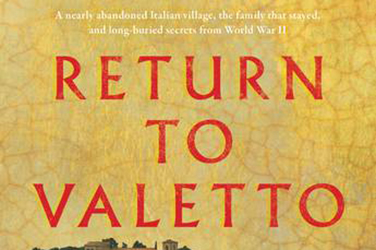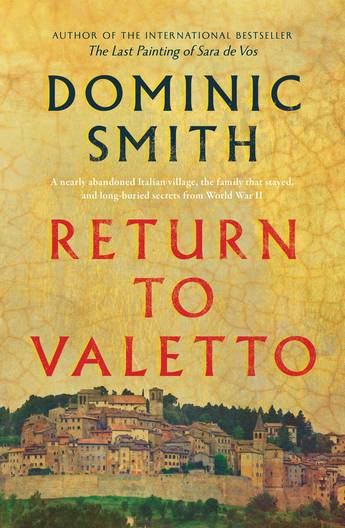
- Free Article: No
- Contents Category: Fiction
- Review Article: Yes
- Article Title: History as filigree
- Article Subtitle: Dominic Smith’s sixth novel
- Online Only: No
- Custom Highlight Text:
A few pages in to Return to Valetto, the narrator Hugh Fisher is on a train from Rome to Orvieto and is being eyed suspiciously by an elderly Italian woman, who can see the photograph of himself with his daughter that he is using as a bookmark:
- Featured Image (400px * 250px):

- Alt Tag (Featured Image): Kerryn Goldsworthy reviews 'Return to Valetto' by Dominic Smith
- Book 1 Title: Return to Valetto
- Book 1 Biblio: Allen & Unwin, $32.99 hb, 368pp
- Book 1 Cover Small (400 x 600):

- Book 1 Cover (800 x 1200):

This is Smith’s sixth novel, and like his previous work, it reflects his cosmopolitan background: the child of an Australian-American marriage, he grew up in Australia’s eastern states but has lived his adult life in the United States, now based in Seattle. And here, as in previous novels, his story roves across continents and cultures and back into the past. Fisher, the main character as well as the narrator, is an academic historian whose specialist area of research is disappearance and abandonment; his book Famous For Dying: A social history of abandoned Italy has earned him this latest trip, where he has received invitations to attend conferences and give guest lectures in various Italian cities.
But for the moment he is on his way to the almost-ghost town of Valetto, a hill village in Umbria whose population consists almost entirely of the Serafino family: his florally named aunts Iris, Rose, and Violet, plus his grandmother Ida, and assorted family retainers. Hugh is the son of the fourth Serafino sister, Hazel, now dead. He teaches history at a college in Michigan but has spent every summer from childhood onwards with his mother in the little stone cottage behind the villa where his aunts and grandmother live; he has inherited it from her, and that is where he plans to stay while in Italy.
The cottage, however, has acquired a squatter, and it is from this surprising and unwelcome development that the novel’s plot unrolls back into the past, and long-buried secrets begin to emerge. ‘We want history to be a unified narrative, a casual, linear plot,’ says Hugh, ‘but I’ve always pictured it like the filigree of a wrought-iron gate, our unaccountable lives twisting and swooping against a few vertical lines.’
Years ago it began to seem to me as a reader of contemporary fiction that World War II and its effects and legacies were still showing up in the human psyche after almost eighty years, coming out like some huge, deep, self-renewing bruise on the skin of history. In Return to Valetto this happens after a chance reference over a family dinner to the former uses of the ‘taverna’, a kind of cellar carved into the bedrock below the villa, where ten refugee children from Turin and Milan had been brought for safety during the war. Hugh is surprised by the fact that neither his mother nor the aunts, children themselves at the time, have ever mentioned this before: ‘They would have known that refugee children sleeping in the villa’s cave-like cellar when the Allies began bombing Italian cities … might have been of interest to a professional historian.’
The reader twigs immediately that such a ‘Why-wasn’t-I-told?’ moment is significant, and at this point the novel spreads its genre wings: not only part travelogue and part family saga, but now also part crime story, part love story, part mystery, part history, perhaps even part romance. And as the novel’s title suggests, there is also the time-honoured literary figure of the revenant, the one who returns to old haunts and shakes things up.
Once it has been decided that grandmother Ida’s hundredth birthday is going to be celebrated with a giant party and sit-down dinner, the plot starts going up through the gears. As with all good parties, this one comes together like some massive, intricate work of art. The reader can see Smith enjoying himself as he describes the plans, the food, the people, and the various small dramas involved as tasks and roles are allotted, while the darker strand of the plot weaves along in parallel. One of the invited guests, who has accepted, is to be Silvio Ruffo, now ninety-six and living in an aged-care facility in Rome, fragile but still in full command of his faculties. Ruffo was the town’s wartime pharmacist, a known fascist and supporter of Mussolini. Revelations will be made, and scores settled.
Dominic Smith lived in the United States all through the rise and the presidency of Donald Trump – for some of that time in Texas – and has seen close up the growing appetite for autocratic, authoritarian rule that has manifested over the past decade in countries across the world. It comes as no real surprise that he would choose with this latest novel to tell a story about the things that can happen under such leadership, and the long-lasting effects an allegiance to its values and priorities can have on human behaviour and on human fates.


Comments powered by CComment